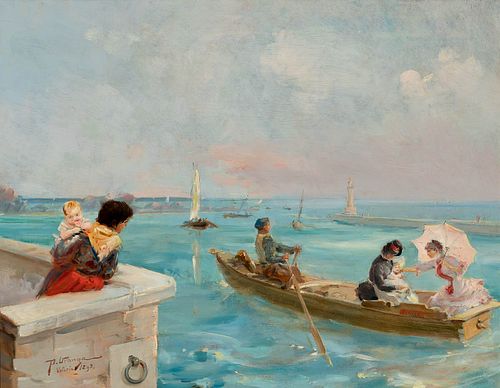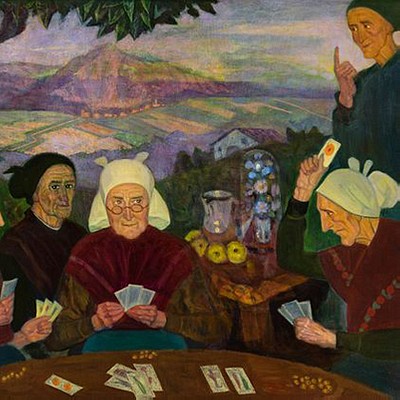PABLO URANGA DÍAZ DE ARCAYA (Vitoria, 1861 - San Sebastián, 1934). "Afternoon stroll", Vitoria, 1892. Oil on canvas.
Lot 106
About Seller
Setdart Auction House
Carrer Aragó 346
Barcelona
Spain
Setdart Subastas was born in 2004 and is currently the first online art auction in Spain with solidity, prestige and reliability guaranteed by our more than 60,000 users. Setdart has a young, dynamic and enterprising team ready to successfully manage the purchase and sale of art works through custom...Read more
Estimate:
EUR€8,000 - EUR€9,000
$8,602.15 - $9,677.42
Absentee vs Live bid
Two ways to bid:
- Leave a max absentee bid and the platform will bid on your behalf up to your maximum bid during the live auction.
- Bid live during the auction and your bids will be submitted real-time to the auctioneer.
Bid Increments
| Price | Bid Increment |
|---|---|
| EUR€0 | EUR€10 |
| EUR€200 | EUR€25 |
| EUR€500 | EUR€50 |
| EUR€1,000 | EUR€100 |
| EUR€3,000 | EUR€200 |
| EUR€5,000 | EUR€500 |
| EUR€10,000 | EUR€1,000 |
| EUR€20,000 | EUR€2,000 |
| EUR€50,000 | EUR€5,000 |
About Auction
By Setdart Auction House
Dec 14, 2021
Set Reminder
2021-12-14 08:00:00
2021-12-14 08:00:00
America/New_York
Bidsquare
Bidsquare : 19th & 20th Century Fine Art
https://www.bidsquare.com/auctions/setdart-auction-house/19th-20th-century-fine-art-7992
Gaudi, Sorolla, Torres Garcia, Maclet, TSUGUHARU FOUJITA, Benjamin Palencia Setdart Auction House sofia@setdart.com
Gaudi, Sorolla, Torres Garcia, Maclet, TSUGUHARU FOUJITA, Benjamin Palencia Setdart Auction House sofia@setdart.com
- Lot Description
PABLO URANGA DÍAZ DE ARCAYA (Vitoria, 1861 - San Sebastián, 1934). "Afternoon stroll", Vitoria, 1892. Oil on canvas. Signed, dated and located in the lower left corner. Work reproduced in color in "Pablo Uranga. The Bohemian of Elgeta", Museum of Fine Arts of Alava, Provincial Council of Alava, p.154. n.46. Measurements: 52 x 68 cm; 71 x 87 cm (frame). The beaches were for Pablo Uranga places where spontaneous enjoyment was expressed in faces, gestures, baths and colors, in people of different social classes and of all ages. Children playing in the sea, elegant mothers watching over them, young people having fun and exchanging confidences, etc. The beach was also a theater box, where people watched the show. In the scene we are dealing with, possibly set on a beach in the Basque Country, one of the ladies wears light white clothes, fluttering in the breeze, while the rest of the characters wear popular costumes. In each of Uranga's paintings, the drawing disappears under the impetus of a brushstroke that captures in glances of reflections, transparencies and splashes the dialogues between the sea, the sky and its people. Pablo Uranga was a Spanish painter whose artistic career began at the School of Fine Arts in Alava, where he studied until 1880. In this year he moved to Madrid, and continued his training at the Royal Academy of Fine Arts of San Fernando. Thanks to the influence of the sculptor Paco Durrio, he later traveled to Paris, where he met artists such as Ignacio Zuloaga and Santiago Rusiño and held his first exhibition in 1897. When he returned to Spain, he moved to the Basque Country, and made frequent trips to Segovia to spend long periods of time with Ignacio Zuloaga in the workshop of the ceramist Daniel Zuloaga, Zuloaga's uncle. From that trip to France his work was marked by Impressionism, although his predilection and knowledge of the Spanish classical school can also be appreciated. His subject matter is very varied, although his portraits, landscapes and works related to the world of bullfighting stand out. His works were exhibited in Zaragoza, Bilbao, Madrid, etc., and they are part of important private collections and institutions such as the Prado Museum and the Reina Sofia Museum in Madrid, the Fine Arts Museum in Bilbao, etc.
- Shipping Info
-
In-house shipping available. Please inquire at admin@setdart.com.
-
- Buyer's Premium



 EUR
EUR CAD
CAD AUD
AUD GBP
GBP MXN
MXN HKD
HKD CNY
CNY MYR
MYR SEK
SEK SGD
SGD CHF
CHF THB
THB
















